#Pest Insects On Flowers
Explore tagged Tumblr posts
Text
Do birds eat slugs?
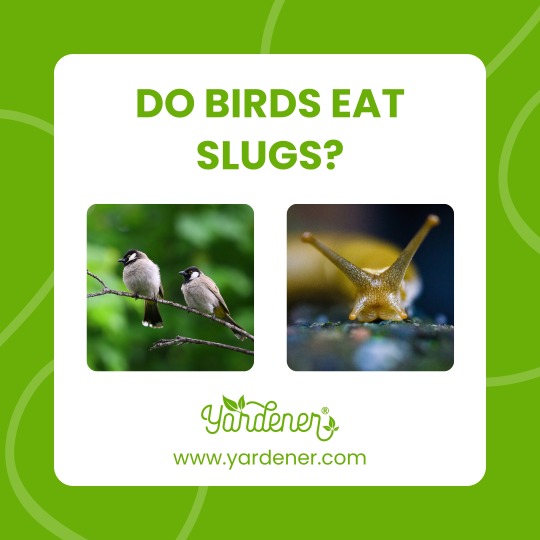
Encourage slug eating birds like thrushes and robins into your garden for free pest control! Set up feeders and habitat to attract these beneficial birds that will happily feast on slugs and snails infesting your vegetable plots and flower beds. Supplement with physical barriers for complete protection.
#gardening#yardener#gardeningtips#gardening tumblr#gardeningcommunity#snail#birds#Do birds eat slugs#Dealing With Pest Insects#Pest Insects On Flowers#Preventing Slugs
1 note
·
View note
Text
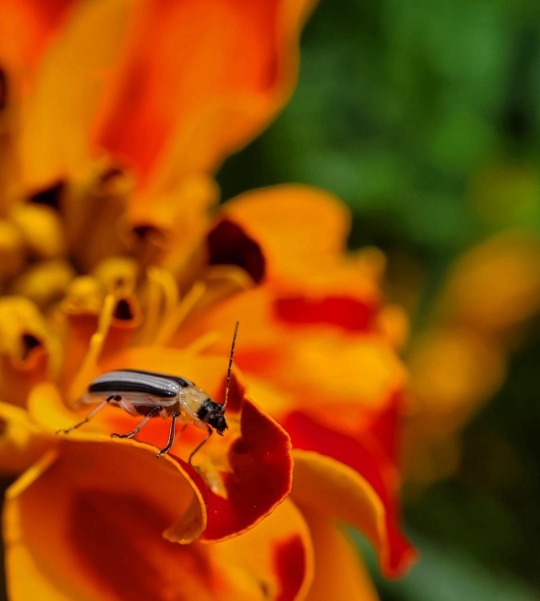
Questing for cucumbers
Acalymma vittatum, Pennsylvania
#beetle#Acalymma vittatum#striped cucumber beetle#coleoptera#nature photography#entomology#nature#bugs#biodiversity#inaturalist#insect appreciation#insects#animals#arthropods#bugblr#garden pests#cucumbers#flowers#natural beauty
17 notes
·
View notes
Text
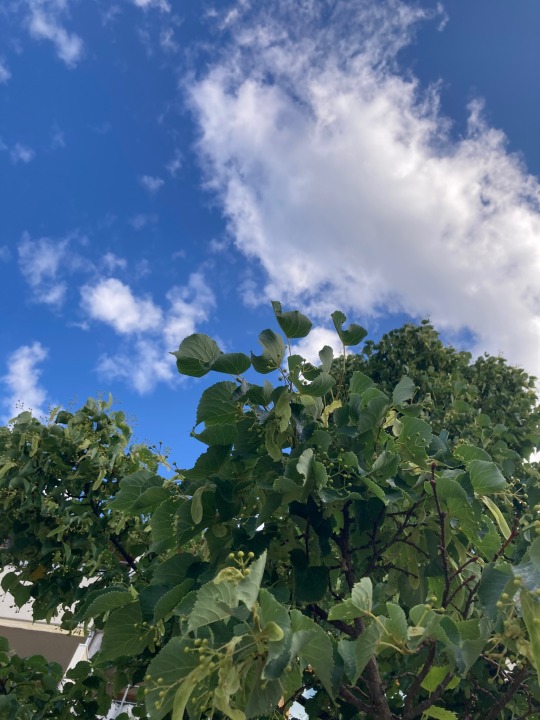



9 notes
·
View notes
Text
May 2023: The Good, The Bad & The Tasty
Striped sweat bee doing what they do best... pollinate:

Volunteer runner beans:

A Common Clearwing moth. This is the moth that lays the eggs that produce squash vine borers. Given their coloration & being diurnal, it is easy to see why they are sometimes mistaken for wasps. This one got stomped:
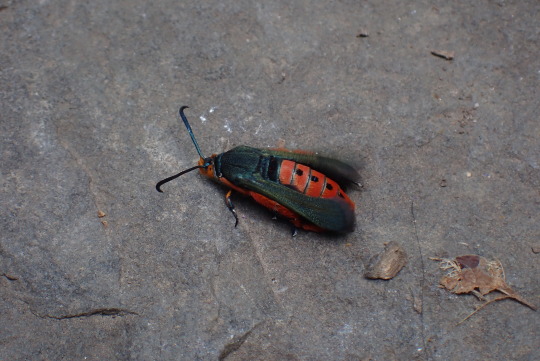
Surf & Turf - chimichurri steak, grilled tilapia with grilled vegetables & grilled limes:

Dinner tonight:
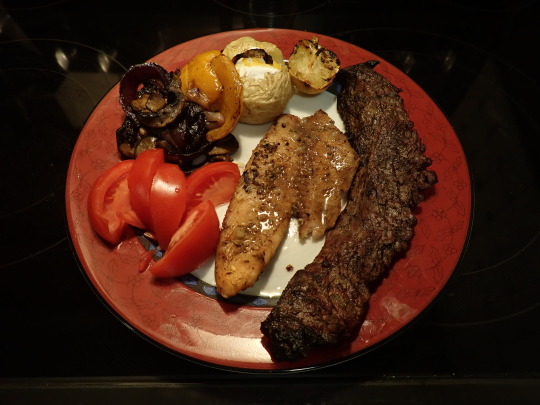
#garden#backyard garden#flower#echinacea#beneficial insect#tiny bee#striped sweat bee#runner beans#pole beans#garden pest#common clearwing moth#squash vine borer#grilling#chimichurri steak#grilled tilapia#grilled vegetables#grilled lime#life in memphis#dinner
3 notes
·
View notes
Text
Moar Discord Requests


She's so precious uwu
#monster beach#termite#termite queen#termites#insects#pests#bugs#uwu#shes so precious#funny#kitten#kitteh#flowers
6 notes
·
View notes
Text
DEET is the oldest, most studied and reliable insect repellant (the next being picaridin, which is less toxic or absorptive, but not nearly as time-tested). However, its exact function for how it repells is still uncertain and:
While DEET isn't an insecticide, it is still a neurotoxin, and could be leaving negative impacts on more delicate wildlife such as pollinators, fish, and insectivorous birds (including hummingbirds! and swallows that cut down on mosquito populations!)
Please use only as directed. Do not spray it into clouds of bugs, puddles, streams, flowerbeds, bushes, or grasses around you as though it's an insecticide; other animals will end up consuming it like one.
I'm trying to write a post about tick safety and avoiding tick bites, but a lot of the info on websites is like "Avoid going in the woods, in plants, and where there are wild animals" and "Activities like hiking and gardening can put you at risk" and I'm like thanks! This is worthless!
As ticks and tick borne illnesses are expanding their range, I think it's important for people to be educated about these things, and I think it's especially important to give people actual advice on how to protect themselves instead of telling them to just...avoid the natural world
Rough draft version of Tick Advice:
Ticks don't jump down on you from trees, they get on you when you brush against grass, brush, bushes etc.
Ticks get brought to an area when they get done feeding from an animal and fall off them. In the USA, the main tick-bringing animal is deer, but I've seen plenty ticks on feral cats and songbirds.
Ticks get killed when they dry out so drier areas with more sunlight are less favorable to ticks.
The above is useful for figuring out whether an area is likely to have lots of ticks, and how vigilant you have to be in that area.
Wear light-colored, long pants outside. Tuck your pants into your socks, and tuck your shirt into the waist of your pants. Invest in light, breathable fabrics idc
IMMEDIATELY change out of your outside clothes when you come back from a tick-prone area, wash them, and dry them on high heat to kill any ticks that might be stuck on.
Shower and check yourself for ticks after coming inside. Hair, armpits, and nether regions in particular. You can use a handheld mirror or rely on touch; an attached tick will feel like a bump kinda like a scab
While you're outside, you can just periodically check for ticks by running your hands down your legs and checking visually to see if anything is crawling on your clothes. Light colors make them easy to spot, and they don't move fast.
Combing through each others' hair to check for creepy crawly critters is a time-honored primate ritual and is not weird. When hiking, bring a friend who will have your back when you feel something on your neck and need to know if it's sweat or a tick
If you're careful, you can usually catch ticks before they bite you, but if one does bite you, it's not the end of the world. Since tickborne diseases are different regionally i suspect this advice will differ based on where you are, but the important thing is remove the tick with tweezers (DON'T use butter, a lit match, or anything that kills the tick while it's still attached, please) and contact a doctor to see what to watch for. Most illnesses you can catch from ticks are easily treatable if you recognize them when symptoms first appear
#we got insane rain storms and massive populations of mosquito/water reliant pest insects as a result and then#most of the time if u could find any spray left in stores at all it was the kind w/ high DEET content bc ppl sprayed cans around their home#(sometimes u get a biblical plague & u gotta just accept u cant go outside as usual. just dont use bad habits & fear the normal outdoors)#its the only explanation so far for why we got so many abandoned baby hummingbirds that developed neurological symptoms n died within days#small insects make up their protein intake & babies need a lot. not to mention contaminated nectar from the flowers that survived the storm#and thats only one of the impacts we saw at my wildlife center last summer
65K notes
·
View notes
Text
Arizona Ash Trees: A Guide to Addressing Distorted Growth and Decline
The Arizona Ash (Fraxinus velutina) is a beloved staple in desert landscaping. Known for its fast growth and lush canopy, this deciduous tree provides ample shade in arid environments like Arizona, where relief from the intense sun is a top priority. Reaching heights of 30 to 50 feet with a spread of 40 to 60 feet, the Arizona Ash is a powerhouse when it comes to creating a cooling oasis in urban…
#anthracnose#aphids#arboriculture#Arizona Ash#ash flower gall mites#ash tree pests#Ash Yellows#Cooperative Extension#Desert Landscaping#drought stress#emerald ash borer#Fraxinus velutina#Pest Management#Pruning Tips#scale insects#tree care#tree diseases#tree maintenance#tree watering#urban trees
0 notes
Text
Blister Beetles: Pretty colors, serious powers
🌿🐞 Did you know about Nuttall’s Blister Beetles? These vibrant insects are a part of our local parks and greenspaces, often found on flowers like lupines and milk-vetch. 🌼 While they may look beautiful with their bright colors, handling them can be risky! 🚫 Their bodies contain cantharidin, a toxin that causes skin blistering if mishandled. Here’s how to enjoy nature safely: 👀 Spot them…

View On WordPress
#beetle biology#beetle diversity#beetle larvae#beetle life cycle#blister beetle#cantharidin#ecosystem balance#entomological study#entomology#environmental impact#flower feeders#flower pests#garden management#garden pests#garden safety#George Genereux Urban REgional Park#greenspace insects#insect anatomy#insect behavior#insect biodiversity#insect defense#insect ecology#insect habitats#insect identification#insect protection#insect toxin#insect venom#Lytta#natural habitats#North American insects
0 notes
Text
more words for worldbuilding (pt. 2)
ANIMALS
Animal: adult, beast, buck, cat, chicken, cur, father, frog, goat, half-breed, horse, hybrid, litter, mongrel, monster, parasite, pig, stock, young
Bird: bird, chicken
Fish: aquarium, aquatic
Group of animals: drove, herd, insect, pack, stock, team
Insect: bee, grub, pest
Limb or appendage of: bill, coat, feather, fur, mop, pelt, scale, trunk, wing
Mammal: cat, dog, father, goat, hound, mother, pig
CLOTHING
Accessory: bag, belt, buckle, collar, pocketbook, purse, satchel
Clothing: apparel, array, bathing suit, cape, clothes/clothing, costume, dress, dungarees, falsies, frock, garment, girdle, gown, hat, jacket, negligee, nylons, pajamas, pants, quilt, scarf, skirt, suit, swimsuit, thing/things, trappings, underwear, veil, wash, wrap
Part: collar, crown, pocket, strand, tiara
State of dress: bareness, nudity, try on/try out, wear
FOOD & DRINK
Beverage: alcohol, coffee, drink, potable
Beverage, alcoholic: beer, liquor
Change in: curdle, turn
Food: appetizer, bite, brew, bun, casserole, condiment, cracker, diet, doughnut, feed, frosting, grub, helping, hors d’oeuvre, leftover, macaroni, meat, nosh, nurture, nutrition, pastry, produce, refreshment, seasoning, stew, subsistence, support, sweet, treat, vittles
Food part: morsel, nip, taste, tidbit
Meal: banquet, bite, buffet, diet, fare, picnic, repast, spread, table
Produced from animal: comfort food, feed, food, frosting, grub, hero, macaroni, sandwich, submarine, vittles
Produced from plant: condiment, doughnut, loaf, pastry, produce, sweet
Quality of: acerbity, baked, done, edible, mellow, nourishing, perishable, rare, ripe, salty, short, stale, strong, sweet, unappetizing, weak, wholesome
NATURAL RESOURCES
Electricity: beam, spark
Energy: electricity, fuel, nuclear energy, petroleum, power
Expression of energy: blast, bonfire, chill, concussion, discharge, fire, flash, noise, thunder
Natural event: eclipse, meteorology, weather
Resources: fuel, resource, rock, substance
PLANTS
Flower: bloom, bouquet, flower
Fruit: berry, produce
Growth or death of: bloom, bud, germinate, growth, wilt, wither
Part: bark, branch, cereal, flavoring, foliage, grain, juice, limb, nut, pod, scion, shell, stalk, trunk
Plant: algae, bramble, bush, crop, fossil, grass, harvest, hybrid, organism, produce, wreath
Tree: timber, wood/woods
Vegetable: produce
WEATHER
Object connected with: avalanche, breeze, climate, cold, dew, film, flurry, frost, gust, haze, hurricane, meteorology, moisture, puff, thunder, weather, wind
Quality of: breezy, clear, close, crisp, dismal, fair, fiercely, fine, furious, gloomy, hazy, humid, intimidating, misty, oppressive, raw, rugged, soft, stormy, sultry, temperate, thick, tranquil, turbulent, wild, wintry
Type of: blizzard, cloud, drizzle, fog, hail, mist, puff, rain, shower, tempest, torrent, tremor
NOTE
Excerpted from Roget's 21st Century Thesaurus, Updated and Expanded 3rd Edition, in Dictionary Form, edited by The Princeton Language Institute.
The above are concepts classified according to subject and usage. It not only helps writers and thinkers to organize their ideas but leads them from those very ideas to the words that can best express them.
It was, in part, created to turn an idea into a specific word. By linking together the main entries that share similar concepts, the index makes possible creative semantic connections between words in our language, stimulating thought and broadening vocabulary. Writing Resources PDFs
Source ⚜ Writing Basics & Refreshers ⚜ On Vocabulary
#worldbuilding#vocabulary#langblr#writeblr#writing reference#spilled ink#creative writing#dark academia#setting#writers on tumblr#poets on tumblr#poetry#literature#writing tips#writing prompt#writing#words#lit#studyblr#fiction#light academia#nature#food#writing resources
456 notes
·
View notes
Text
A knight second chance 4
Pyrrha: *looking around* ... Where did Jaune go?
Nora: *sucking tree sap like a vampire* 'unno, he 'as he'e a se'on's a'o.
Ren: I think i heard him say something about Ursa.
Pyrrha: *panicking* He could be in danger! Trying to kill them by himself.
Both Ren and Nora looked at her, deadpan
Pyrrha: W-what!?
Nora: Pyrrha, Jaune out-stamina ME during my morning routine WHILE doing twice as much. He might not be as flashy as us, But the guy just doesn't stop!
Ren: *nod* His aura control is immaculate, which is really impressive for someone who didn't have his aura unlocked until initiation.
Pyrrha: H-how... When!?
Nora: Oh he told us in the first two weeks... Wait, we didn't tell you?
Pyrrha: NO! I THOUGHT HE WAS HIDING IT!!
Nora: Eheh... Oups?
___________________________________________
Cardin: *looking at the friendly Jaune ripping the head of the ursa with his bare hands* ... Holy shit, is that why you only go for ring out!?
Jaune: *looking back at Cardin with a smile* Oh it's quite easy actually. You just have to twist the head!
Cardin: ... *Looking at the sap on the ground* And i almost threw that at your teammates as a prank. Thanks GODS i didn't, it could have been dangerous!
Jaune: Especially with rapier wasps.
Cardin: *confused* Rapier wasps? What are you talking about?
Jaune: Wait... You weren't planning on sending rapier wasps on my team?
Cardin: What!? NO! And where would we find those anyway!?
Russel: ... My girlfriend does have a wasp farm.
Cardin: *looking at his friend* WHAT'S WRONG WITH YOUR GIRLFRIEND!?
Russel: *shrug* Her semblance gives her control over some insects and they are natural predators for most pests. She likes her garden clean.
Dove: Flower or food?
Russel: *turn to Dove* Both. Oh, by the way, she made us blue and blackberry jam!
___________________________________________
Pyrrha: *blushing* ... He barely moved when the ursa rammed into him. He stood his ground like a knight...
Ruby: *slight blush* And the way he just casually decapitated the ursa while continuing to smile, as if to say nothing wrong could happen...
Weiss: *blushing hard, staying silent* ...
#jaune arc#pyrrha nikos#nora valkyrie#lie ren#cardin winchester#russel thrush#dove bronzewing#ruby rose#weiss schnee#a knight second chance
231 notes
·
View notes
Note
hello! i am a relatively new user here on tumblr, less than a year, and i have heard a comment or two about a 'wasp discourse' that happened here, that wasps are much more nice than bees or something among those lines
this caught my curiosity as im writting a wasp based character whos just an ahole as i did it on what i knew abt them from general internet and im stuck on wether i should maaayybe change them up a bit
if its not too much to ask do you happen to know a bit abt this discourse? or have a link to it? or if not to the discourse itself some other link that elaborates abt the same topic? perhaps even someone else i can ask this?
thank you very much!
to start off, there are a lot of bees and wasps in this world and it is not easy to generalize about them. there are ~20,000 bee species, and the vast majority of these are solitary bees that nest in the ground, plant stems, or in holes in wood, and because they produce no honey or have a colony to guard, have no need to be defensive or aggressive towards humans (because “towards humans” seems to be what most people base this idea off of). colonial bees, like honeybees, are actually much more defensive than solitary ones; they have huge food stores and many defenseless larvae, hence their nasty stings (or bites, for the stingless bees) and swarm defense of their hives.
bees, however, are just a family of wasps. their closest relatives are believed to be the crabronid wasps (example: cicada killers) and sphecid thread-waisted wasps (ex. mud daubers). these wasps, and most others, are also largely solitary, and hunting prey aside, don’t typically use their stings for anything other than personal defense. of the hundreds of thousands of wasps, most of them (75%) are not just solitary but also parasitoids that develop inside other insects. it’s hard to say “all wasps are assholes [to people]” when some 100,000 of them are tiny specks smaller than sesame seeds that nobody other than scientists notice.
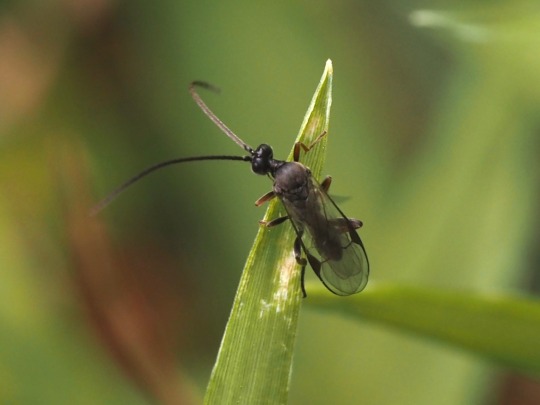
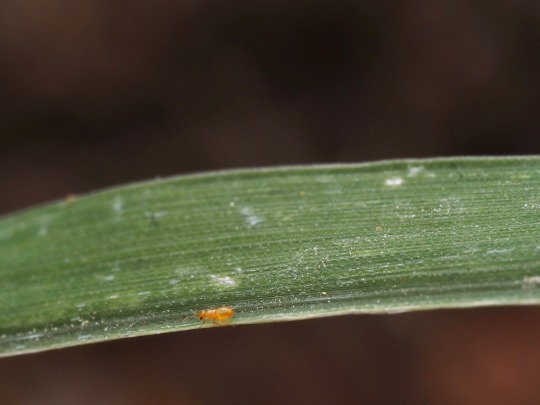
two parasitoids: a braconid ~3mm long & something else ~0.3mm long
the wasps most people take issue with are vespids, since they like the same foods we do (sweets, meat) and have powerful stings to defend their nests. these include the social hornets, yellowjackets, and paper wasps, but many mason wasps and the like are solitary (and, you guessed it, want nothing to do with people). vespids are great predators of caterpillars, flies, and other pests that humans don’t like in addition to being pollinators.
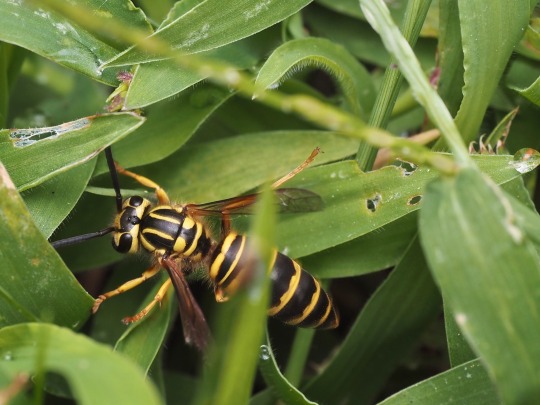
a yellowjacket: Vespula squamosa
the usual anti-wasp, pro-bee sentiments go: wasps attack for no reason, don’t pollinate, don’t make honey, and are “assholes.” wasps do pollinate (most wasps, bees and ants don’t eat solid food, and therefore largely drink flower nectar; some plants are only pollinated by wasps).
some tropical wasps do actually make honey, though it’s not harvested by humans. it’s sort of silly to say that making honey is what makes bees “good” though—a very selfish mindset, and for example butterflies are well-liked by people despite not making any edible products for us.
wasps also attack only when provoked, either because you’re near a wasp nest or when you lean on one accidentally. they are defending their baby sisters and themselves, same as bees would. at least in the US, I think the reason that wasps are so hated is that we have many species of paper wasp and yellowjacket that are willing to nest on or under houses, while the (invasive) honeybees prefer trees or are kept by beekeepers in artificial hives, so it’s just more likely you’ll run into problems with wasps than bees.
tl;dr:
wasps and bees are neither “nice” nor “mean.”
bees are mostly loners that don’t bother people. colonial bees will sting to defend their nests or themselves from predators. most bees are pollinators, who gather pollen to feed their larvae. a few species make honey that humans harvest.
wasps are mostly loners that don’t bother people. colonial wasps will sting to defend their nests or themselves from predators. most wasps are pollinators, and most hunt or parasitize other insects to feed their larvae.
1K notes
·
View notes
Text
The trolls as insects (i might draw them later)


Aradia Megido - Maroon Ghost Moth (Elhamma australasiae)
Moths have been repeatedly portrayed as a sign of death. Also, their fluffiness matches the one of Aradia's hair XD. When I read this one's name it was inevitable (ghost???, maroon??, literally her oh my gooood).


Tavros Nitram - Question Mark Butterfly (Polygonia interrogationis)
Mostly based off of the Summoner and Rufioh having wings, I didn't want to make it a monarch butterfly because Tavros is in no way royalty.


Sollux Captor - Western Honey Bee (Apis mellifera)
Pretty self explanatory, Sollux always had a connection (and obsession) with bees. They also sting, which is kind of a metaphor for the psionics.


Karkat Vantas - Seven Spot Ladybird (Coccinella septempunctata)
Ladybirds are always seen as special, even though this instance is not a mutation per se, it's special and red. Also, ladybirds are commonplace pests (which is kind of what Karkat is to HIC).


Nepeta Leijon - Pale Green Assassin Bug (Zelus luridus)
I looked up some good bug hunters and I got assassin bugs, nepeta is the mightiest of huntresses, so it fits.


Kanaya Maryam - Green Headed Ant (Rhytidoponera metallica)
I was doubting wether to make Kanaya an ant or a silk moth, but ultimately, moths are a better representation of Aradia, and ants mimic jade-blood's function in troll society better. A part from being green, this species of ant apparently has a nice bite, which is representative of Kanaya's fierceness.


Terezi Pyrope - Ebony Jewelwing (Calopteryx maculata)
I am aware that the dragonfly pictured is male, just ignore that lol, headcanon the trolls as hermaphroditic (i will post about their biological cycle hehe). Dragonflies are said to be insect's best predators, Terezi is also a vicious and precise hunter, if not of other trolls literally, of outcomes and possibilities (she is intelligent, and a Seer of Mind).


Vriska Serket - Peacock Tarantula (Poecilotheria metallica)
Also pretty self explanatory, it's a blue spider, therefore Vriska Serket. Spiders in general are already a good representation of how she is percieved (with fear lol). Yea, simple explanation.


Equius Zahhak - "Pure Blue" Giant Flower Beetle (Mecynorhina torquata)
The strongest of bugs are beetles (among some types of ants, who are better described as proportionally strongest). This particular one is also pretty big and strong, and coincidentally presents this type of coloration.
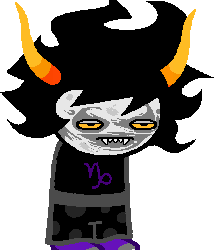

Gamzee Makara - Purple-Winged Grasshopper (Titanacris albipes)
Originally was going to be a praying mantis, but the orchid mantis was just too perfect for Feferi. Locusts also have ties to religion and mythology, which was my main focus for finding Gamzee's insect (they have been, fittingly, a symbol of destruction for eons).
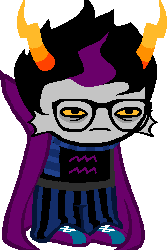

Eridan Ampora - Canopy Mosquito (Sabethes cyaneus)
Tbh, I based most of this decision off of the fact that Eridan is annoying (I don't hate him, it's just his personality, unfortunately). Also, mosquitos breed in water (at least that's what my parents always told me) which matches the aquatic theme.
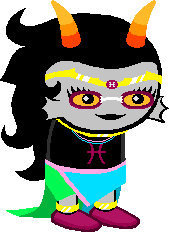

Feferi Peixes - Orchid Mantis (Hymenopus coronatus)
Feferi is the troll I had the most trouble with. Originally I tried keeping up with the aquatic theme and had found Ranatra linearis, a stickbug that looks like a mantis and hunts little fish. I discarded the option because even though it was aquatic, the connections with Feferi kind of ended there.
I then tried to search for a bug that had "empress" in the name, and had chosen Megapomponia imperatoria, a giant as fuck cicada. It didn't convince me either though.
I chose the orchid mantis because, mantises are cutthroat, good hunters and pink as fuck. If that's not a description of the tyrian blood caste I don't know what is.
I wanted to make one of these drawing comparisons to different species of ants. There exist some cool af ants out there, I might do it.
#aradia megido#tavros nitram#sollux captor#karkat vantas#nepeta leijon#kanaya maryam#terezi pyrope#vriska serket#equius zahhak#gamzee makara#eridan ampora#feferi peixes#insects#homestuck
108 notes
·
View notes
Text


Wheel Out the Wheel Bug
The wheel bug, also known as Arilus cristatus, is a member of the assassin bug family found throughout eastern North and Central America. They thrive in a variety of environments including grasslands, deciduous and tropical forests, and gardens; anywhere where flowers are abundant.
The wheel bug is so named for the distinctive, spiny wheel-shaped hump along its thorax and abdomen. The body is otherwise elongated and dark grey with white spotting. As an assassin bug, the species also sports an enlarged proboscis for deeding. This species is also noted for being one of the largest true bugs endemic to North America, at a whopping 3.8 cm (1.5 in) long.
As an assassin bug, A. cristatus is a voracious predator within its natural habitat. Individuals catch caterpillars, beetles, sawfly larvae, aphids, and stink bugs with their long forelimbs and then inject their target with a potent paralytic, dissolving its insides and slurping up the resulting soup. Due to their spiky bodies and painful bite, the wheel bug has few natural predators. However, eggs are often prey to parasitic wasps.
Wheel bugs begin mating in September and continues throughout the fall. After mating, the female lays anywhere from 40 to 200 eggs on a leaf, in a cluster resembling a cylindrical honeycomb. The eggs incubate over the winter and juveniles emerge the following spring. They mature throughout the summer and become full adults the following fall, where they mate and then die.
Conservation status: The wheel bug has not been evaluated by the IUCN, but populations are widely dispersed throughout its range and the species is generally ecologically stable. In many areas, it is one of the only predators of other invasive or pest insect species.
Photos
Rick Kelly
Seth Ausubel
Richard Orr
#wheel bug#Hemiptera#Reduviidae#wheel bugs#assassin bugs#true bugs#bugs#insects#arthopods#generalist fauna#generalist arthropods#grasslands#grassland arthropods#urban fauna#urban arthropods#north america#eastern north america#central america#eastern central america
104 notes
·
View notes
Text

#oak gall#gall wasp#cynipini#insects#pests#oak flowers#fallen flowers#quercus#flowering trees#microflora#forest floor#sveadal
0 notes
Text
30 Random Things to Worldbuild For Fun/When Bored
Pet Breeds
Unorthodox Jobs
Tree Species
Flower Species
Local Festivals & Fairs
Military Ranks
Weapon Laws
Pets
Insects
Local Pests
Beauty Standards
Alcohols & Recreationals
Edible Freshwater Fish Species
Local Cuisine
Children's Pastimes
Romance Rituals
Musical Instruments
Desserts
Folklore
Religious Rituals
Diseases
Genetic Anomalies
Local Prey Species
Sports
Card/Board Games
Language Dialects
Collectables
Common Brands/Companies
Stupid Laws
Uniforms Found Around Town (Jobs, Schools, Religion, Guilds, etc.)
100 notes
·
View notes
Text

BUG ID PACK

NAMES︰ adalia. adam. agatha. amber. andrena. ant. antony. aranea. arthro. aspen. attacus. beckett. bee. beetle. behan. benjy. bogárka. bubonic. bubonicholas. bubonick. bugsy. buzzie. býleistr. carrie. celastrina. cesare. cheli. chelicera. chrysalis. coley. cordulia. craniifer. crawly. creepy. critter. cuddlebug. dahlia. danuria. destiny. diseaselie. dishevella. dishevelle. dusk. dust. ella. ellsee. emery. eve. fern. fester. fifi. firefly. giselle. glimmer. hawk. hexa. hisser. hive. honey. hope. infestatianne. instar. jan. jeb. jed. jeddie. jeddy. jewelette. junebug. kaida. kaira. kieran. ladybird. lepidoptera. lester. lightsse. logan. lorcan. lovebug. luciole. luna. lyssa. mandela. mandibella. mandibelle. mandible. mangie. mangy. mantis. maurr. maxwell. midge. mikio. minii. mold. monarch. mordecai. mordechai. mordekai. mordy. mortimer. morty. moth. mould. naoki. nettle. ogtha. opal. osa. paul. pepper. phobianna. phoenix. ralph. ralphie. ralphy. ratianna. ratianne. ration. ravenesse. ravenette. ravenous. rex. rhene. rhyssa. roach. roark. rolf. ronan. rotgut. rowan. ruddy. rudy. ruth. salvia. scorpio. scurry. scuttle. sicknesse. sicknette. skittish. snugglebug. tawny. terry. thorax. toffee. vanessa. vespasiano. wesley. whiskey. wren. writhe.

PRONOUNS︰ ant/ant. antenna/antannae. antenna/antenna. anthill/anthill. aphid/aphid. arachnid/arachnid. arachnid/arachnids. arthropod/arthropod. bee/bee. bee/beetle. beet/beetle. beetle/beetle. bu/bug. bug/bug. bug/bugs. butterfly/butterfly. buzz/buzz. bzz/buzz. centipede/centipede. change/change. cicada/cicada. click/click. cloth/cloth. crawl/crawl. creepy/crawly. cricket/cricket. damp/damp. dig/dig. dirt/dirt. dragonfly/dragonfly. dusk/dusk. dust/dust. ely/elytra. en/entomology. ento/entomology. exo/exoskeleton. exoskele/exoskeleton. fate/fate. fester/fester. firefly/firefly. flea/flea. flow/flower. flutter/flutter. fly/butterfly. fly/fly. forest/forest. fy/fly. glow/glow. grey/grey. grime/grime. grime/grimy. hex/hexapod. hiss/hiss. hive/hive. hornet/hornet. hun/hungry. infect/infect. infest/infestation. inse/insect. inse/insectoid. insect/insect. insect/insectoid. it/it. jewel/jeweled. lady/ladybug. ladybug/ladybug. lamp/lamp. lice/lice. light/light. lin/linger. lost/lost. lur/lurk. mange/mangy. mant/manti. mantis/manti. millipede/millipede. mite/mite. mo/moth. mosquito/mosquito. moth/moth. night/night. pest/pesticide. pho/phobia. ro/roach. ro/roache. roach/roach. rot/gut. scarab/scarab. scurry/scurrie. scurry/scurry. scut/scuttle. sick/sickly. sick/sicknes. spider/spider. star/star. sting/sting. swarm/swarm. termite/termite. tin/tiny. twitch/twitch. venom/venom. ver/vermin. wasp/wasp. web/web. weevil/weevil. win/wing. wing/wing. worm/worm. 🐌 . 🐛 . 🐜 . 🐝 . 🐞 . 🕷 . 🦂 . 🦋 . 🦗 . 🦟 .

#pupsmail︰id packs#id pack#npt#name suggestions#name ideas#name list#pronoun suggestions#pronoun ideas#pronoun list#neopronouns#nounself#emojiself#bugkin#bug therian#insectkin#insect therian
136 notes
·
View notes